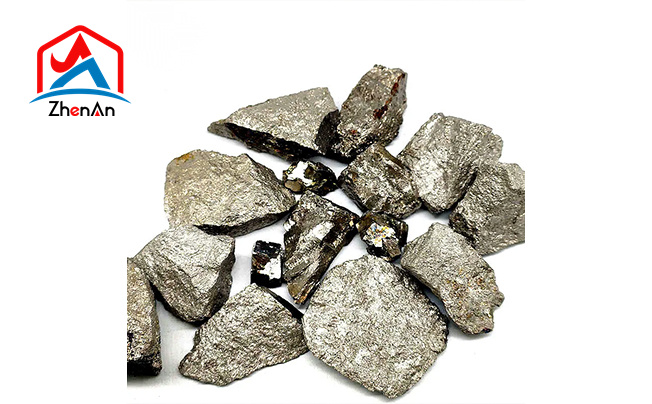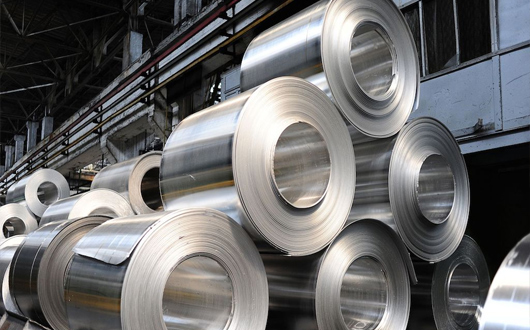| Alloy Type |
Main elements |
Main Use |
| FeCr – ferrochromium |
Fe, Cr |
Stainless |
| FeMo – ferromolybdenum |
Mo 65 - 75
Fe 22.75 - 32.75
Silicon, Si: 1.5
Copper, Cu: 0.50
Carbon, C: 0.10
Sulfur, S: 0.10
Phosphorous, P: 0.050 |
High strength low alloyed |
| FeNb – ferroniobium |
50-80%Nb |
High temperature application and steel |
| FeNi – ferronickel |
Ni 30%-90% |
Widely used for stainless, steel and 3D printing |
| FeSi – ferrosilicon |
15–90% Si
|
Corrosion-resistant, high-temperature-resistant, electromotors and transformer cores |
| FeTi – ferrotitanium |
Ti 30%
75% Ti,
max. 5–6.5% Al,
max. 1–4% Si |
Low carbon steel, high temperature and superalloys |
| FeB – ferroboron |
12–20% of boron,
max. 3% of silicon,
max. 2% aluminium,
max. 1% of carbon |
quenching degree and mechanical behaviour of steel and in high-quality alloy steel |
Properties Of Ferro Alloy
Strength and Durability: Ferroalloys are known for their excellent mechanical properties, such as high tensile strength and toughness. These qualities make them suitable for structural applications in construction, where steel beams and columns provide the strength needed to support buildings and bridges. Additionally, the durability of ferroalloys ensures the long-term integrity of these structures, even in challenging environmental conditions.
Corrosion Resistance: Stainless steel is an iron alloy that is valued for its excellent resistance to corrosion and staining. This property makes it an ideal material for applications that require hygiene and resistance to harsh chemicals or moisture. Stainless steel is often used in kitchen appliances, food processing equipment, chemical processing plants, and building elements.
Magnetic Properties: Iron alloys are often ferromagnetic, meaning they have the ability to become magnetized. This property can be used to produce transformers, motors, generators, and a variety of electronic devices. The magnetic properties of iron alloys make them essential in industries where electromagnetic fields are used for a variety of purposes.
Heat Resistance: Some iron alloys, especially those containing alloying elements such as chromium, molybdenum, and nickel, exhibit excellent heat resistance. These alloys can withstand high temperatures without significant deformation or oxidation. They are often used in applications such as jet engine components, exhaust systems, and furnaces.
Wear Resistance: Iron alloys such as tool steels and certain cast irons are known for their exceptional wear resistance. Tool steels, for example, are used to produce cutting tools, dies, and molds because of their ability to hold their cutting edge and withstand abrasive wear.
Cost-effectiveness: Ferroalloys are often preferred for their cost-effectiveness, as they are readily available, easy to manufacture, and have a wide range of applications. For example, carbon steel is used in the automotive industry for chassis and body parts due to its affordability and good mechanical properties.
Machinability: Certain ferrous alloys are designed for ease of machining. For example, free-cutting steels contain additives such as sulfur and lead to improve machinability. These alloys are used to produce precision components and fasteners.
Steel Production: Ferroalloys are the main raw materials for the production of steel. In the process of manufacturing steel, various elements in ferroalloys are mixed in specific proportions to adjust the hardness, toughness, corrosion resistance and other properties of steel to meet the needs of different fields.
Stainless Steel Manufacturing: Stainless steel is a special steel alloy that is resistant to oxidation and corrosion, mainly composed of elements such as iron, chromium, and nickel. Stainless steel is widely used in kitchenware, building materials, chemical equipment and other fields, and is highly favored for its corrosion resistance, beauty, and easy cleaning.
Alloy steel manufacturing: Alloy steel refers to steel that improves its performance by adding other metal elements (such as nickel, chromium, molybdenum, etc.) to iron. Alloy steel has high strength, hardness, wear resistance and corrosion resistance, and is widely used in automobile manufacturing, aerospace, machinery manufacturing and other fields.
Cast iron manufacturing: Cast iron is an iron alloy with a high carbon content and good fluidity and wear resistance. Cast iron is widely used in automotive parts, mechanical parts, building structures and other fields, and is an important structural material.
Magnetic materials: Certain alloying elements in ferroalloys can give materials magnetism and are widely used in the manufacture of magnetic components such as motors, transformers, and sensors.
Alloy additives: Elements such as silicon and manganese in
ferroalloys are often used as additives to other alloys to improve the mechanical properties, corrosion resistance and other characteristics of the alloys.

